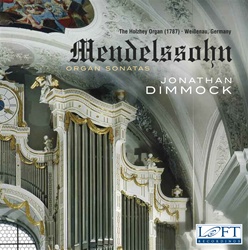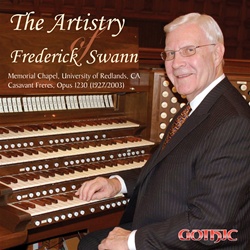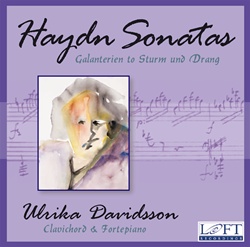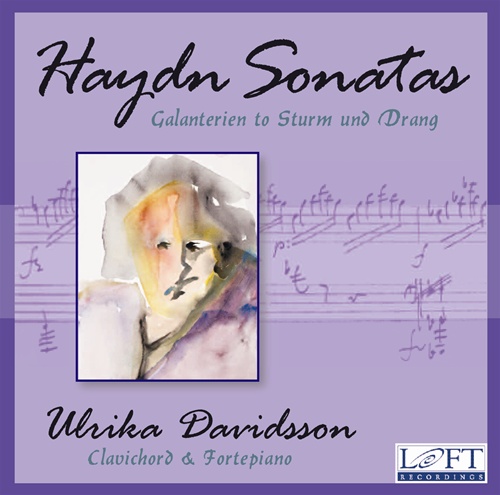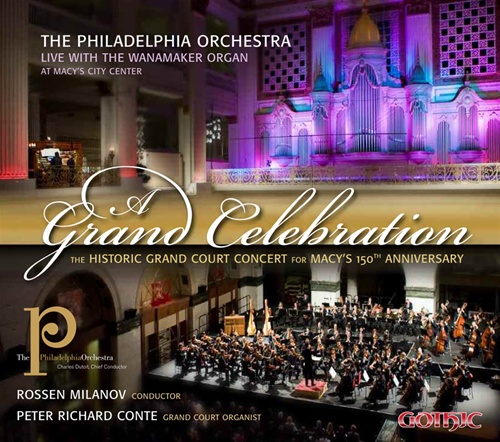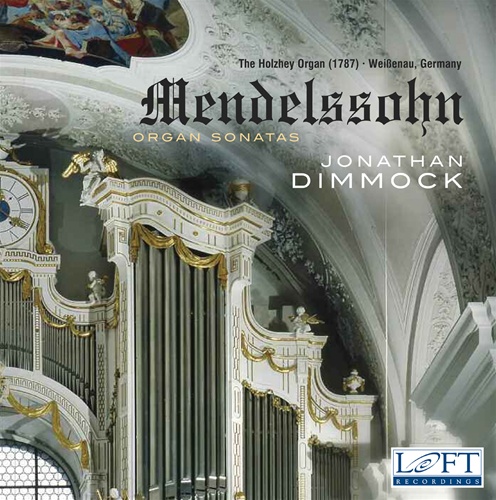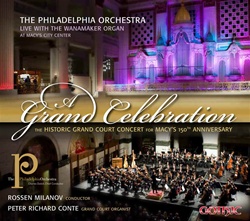 A Grand CelebrationThe Philadelphia Orchestra live with The Wanamaker Organ at Macy’s Center City
A Grand CelebrationThe Philadelphia Orchestra live with The Wanamaker Organ at Macy’s Center City Rossen Milanov, Conductor
Peter Richard Conte, Grand Court Organist
After a wait of over eighty years, the vast tonal palette of The Philadelphia Orchestra is joined, once more, with the world’s greatest symphonic pipe organ for this historic concert! Recorded live, September 27, 2008. Includes Joseph Jongen's Symphonie concertante, which was commissioned for the Wanamaker organ and the Phildelphia Orchestra in the 1920's, but never performed together until this "Grand Celebration".
Program:
Marcel Dupré: Cortege and Litany
Jongen: Symphonie concertante
Allegro molto moderato
Divertimento: Molto vivo
Lento misterioso—Appassionato—Tempo I
Toccata (Moto perpetuo): Allegro moderato
Elgar: Pomp and Circumstance, Military March in D major, Op. 39, No. 1 Cortege and Litany, Op. 19, No. 2, for organ and orchestra — Marcel Dupré Marcel Dupré, the foremost French organist-composer of the mid-20th century, received international acclaim from American concert tours sponsored by the Wanamaker department stores in Philadelphia and New York. In the Grand Court in Philadelphia in 1922 Dupré spontaneously improvised a full symphony from submitted themes on the life of Christ at the Wanamaker Organ. It was subsequently written down as his Symphony-Passion. Another work from Dupré’s American period is the Cortege and Litany. It has a complicated history and exists in several versions. It originally formed part of a suite of incidental music that Dupré composed for a Paris play, and was conceived in terms of a chamber orchestra. The composer also made an arrangement for piano, and when his American concert agent, Wanamaker Stores music director Alexander Russell, heard it, he persuaded Dupré to make two more arrangements—one for organ solo and this one for organ and symphony orchestra. The first performance of this organ- orchestra version, Op. 19, No. 2, was given on February 11, 1925, in the New York Wanamaker Auditorium by Henry Hadley and 70 men from the New York Philharmonic. From a plaintive beginning the work builds with prayer-like petition—tightly weaving two themes at a climax that culminates in a torrent of fiery chords.
—Ray Biswanger
Symphonie concertante, Op. 81, for organ and orchestra — Joseph Jongen Joseph Jongen used to refer to his Symphonie Concertante fororgan and orchestra as “that unfortunate work.” True enough, it did run into a number of obstacles on the way to its unveiling. Commissioned in 1926 by Philadelphia department store owner Rodman Wanamaker, the work was intended for the inauguration of the newly enlarged Wanamaker Organ, which had become an enormous instrument with 28,482 pipes and 461 ranks, since itsinstallation in the store in 1911. Jongen was set to travel to Philadelphia in the early part of 1928 to play the premiere, but he postponed his trip with the passing of his father in the fall of 1927. Delays in the enlargement project pushed the premiere back again, this time to the end of 1928, but the planned concert was scrapped altogether after Mr. Wanamaker’s unexpected death that March. Instead, the Symphonie Concertante had its premiere in Brussels later the same year; the American premiere finally took place at Carnegie Hall in 1935. Fortunate to have survived its difficult birth, the Symphonie Concertante is now considered one of the greatest works for organ and orchestra of the 20th century.
For the Symphonie, begun in 1926, Jongen calls on singing melodies and traditional forms, offers immediate emotional gratification, and requires an organist of almost superhuman capabilities. As Jongen’s friend Eugène Ysaÿe pointed out, the Symphonie Concertante might better be called a symphony for two orchestras, since “the role you assign to the King of Instruments and its abundant resources ... is not limited or restricted; it is clearly a second orchestra that enriches the first.” At 35 minutes of almost non-stop, rigorous playing, this “second orchestra” can be manifested only by a veritable Jedi Master of the organ, one who has the brawn, stamina, and grace—in a word, the force—to stand up to the thickly scored orchestra and make the King of Instruments dance.
The sprightly opening movement defies the organ’s potentially overwhelming strength with a richly textured yet weightless jaunt through a fugal figure begun in the orchestra. About this opening Jongen wrote: “Unlike many composers who have recourse to fugues at the end of their work, the present composer has introduced a fugue at the very beginning.” And to great effect: The sonata-form movement is a conversation between two giants, alternating and combining themes. It closes with a surprisingly understated, quietly lyrical chord and pedal note.
The second movement begins as a scherzo with a quick, almost improvisatory passage for organ. This alternates with slower, more expressive music throughout, with a 7/4 meter that gives the movement a delightfully impish awkwardness, like twisted carousel music. This theme is transformed into a solemn song, and folds in hints of the first movement’s opening fugal statements. After a great swell in the orchestra and a journey for the scherzo theme through a range of orchestral colors, this movement, too, ends quietly: organ, harp, and flute in arpeggiated dialogue, culminating with a delicate triangle stroke conjoined to the final organ pedal.
For the third and longest movement, Jongen said that he wanted “organ and orchestra to realize the best union possible” through a close interplay of instrumental colors. It begins with a sexy flute solo whose color rolls out into harp, woodwinds, and finally strings. Luminous calm builds ever so slowly toward a dark, passionate climax with an explosion of brass and organ. The mysterious sparkle of organ, harp, woodwinds, and strings returns, and the movement wanes again into peace.
The tranquility of the slow movement is shattered by the brilliant Toccata finale. It’s the testosterone-driven showpiece for both orchestras, the gratification that has been so sweetly delayed for the first three movements. Written in the style of the great French toccatas of Widor and Vierne, the grueling and radiant moto perpetuo organ part carries the movement through a series of increasingly intense climaxes. Urgent calls and responses between organ and orchestra, particularly brass, ascend to a forceful coda, which blazes to the end.
In this performance, the work is played for the first time on the organ Joseph Jongen envisaged as he created the piece.
—Meg Ryan
Pomp and Circumstance, Military March in D major, Op. 39, No. 1 — Edward Elgar Elgar’s best-known work is neither the “Enigma” Variations of 1899 nor the Cockaigne Overture of two years later. Everyone who has graduated from high school or college is familiar with the melody that forms the Trio of his first Pomp and Circumstance March, composed in 1901. Many of us, in fact, have heard the tune hundreds of times, unaware of its composer or its source. Certainly no one would deny its catchiness. Elgar, too, knew that he had a hit on his hands as soon as he had written it. “I’ve got a tune that will knock ‘em—knock ‘em flat!” he wrote to a friend. Later in life he referred to the melody as “a tune that comes once in a lifetime,” expressing regret that he had not made use of it in a more substantial work such as a symphony or an oratorio. Nevertheless the Pomp and Circumstance No. 1 was a huge success at its premiere in Liverpool on October 19, 1901, under the baton of Alfred Rodewald. “Your splendid marches were the greatest success I have ever witnessed over a novelty at any concert,” wrote his friend, August Jaeger.
Elgar did manage to reuse the melody once, in 1901. Having been told that Edward VII, who was scheduled to be crowned in June 1902, had heard the March and liked the Trio very much, Elgar set the tune to the hymn “Land of Hope and Glory,” which formed a part of the Coronation Ode he composed for that occasion. In this form, the melody went on to become a favorite accompaniment for formal processions—first in England, and then in the U.S.
The D-major Pomp and Circumstance is one of five marches composed between 1901 and 1930 and later published as a single opus. Stately and perfectly suited to processionals, each of these consists of several sections of contrasting character. The D-major March begins with a fiery, chromatic introduction that leads into the vigorous main theme in D major, scored for full orchestra. The G-major tune that we all know is heard in the subsequent section, which forms the Trio of a scherzo-like structure. The climax is built through a return of the opening material, but before the march is concluded the Trio returns once more, in cymbal-crashing, drum-beating splendor.
—Paul J. Horsley
 Vater Unser im Himmelreich (Click "play" for promo)
Vater Unser im Himmelreich (Click "play" for promo)
